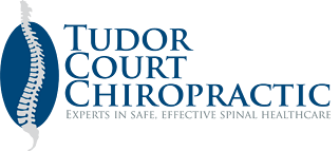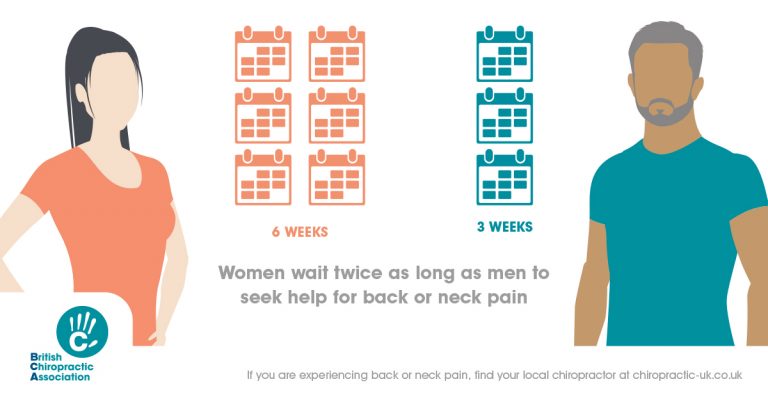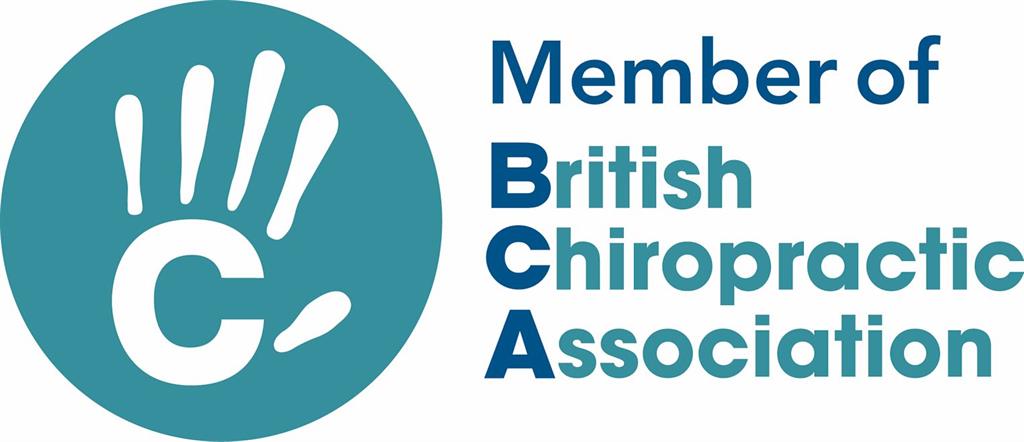New research reveals that women could be neglecting their back or neck health as they take twice as long, six weeks on average, to seek help for their pain, while men take just three. The consumer research also found that women, on average, develop back or neck pain at the age of 27, six years younger than men and experience it more regularly. Despite this, a quarter of women have never visited a health professional for their pain.
In addition, the findings from the British Chiropractic Association reveal that more than a third of women are turning to over the counter medication as a first port of call, 12% more than their male counterparts, ignoring simple fixes such as exercise and stretching which can prevent and improve back or neck pain. In contrast, men are most likely to turn to their GP when initially experiencing pain.
Whilst women are least likely to seek help, the BCA found that overall over a third (34%) of Brits would wait a month or more to seek professional help for back or neck pain. Moreover, one in ten Brits would continue to suffer in silence, not seeking help at all.
Simple lifestyle changes, such as stretching and incorporating more movement into your daily routine, can be an easy and effective way to keep the back pain at bay, yet only 11% of men and women make these changes to their routine when they start to experience back pain.
This trend for women to ‘keep calm and carry on’ is also reflected in their delay in seeking help for other health conditions, with men seeking professional help for joint pain, strains and headaches more quickly than women.
For the majority of back pain sufferers the discomfort of back and neck pain can be eased or prevented by maintaining a strong, active body which is able to cope with the demands made of it, as described in a recent series of paper on back pain in The Lancet.
Top tips for women with back or neck pain:
• Keep moving: Almost half (47%) of female respondents pointed to sitting still for a long time as a key trigger for their pain. If you are required to sit in one position for extended periods of time, at work or on a long drive for example, try to take breaks to walk around, stretch and move your joints and muscles every 30-60 minutes.
• Hit the gym: Incorporating moderate exercise into your lifestyle will help you to build a stronger body that is better placed for dealing with the demands you make of it. If pain is preventing you from exercising, try a form of exercise, such as swimming, which will put less pressure on the joints while allowing your body to move.
• Stretch it out: Stretching can be a beneficial way to keep your joints and muscles active. The BCA’s Straighten Up programme of simple exercises can be incorporated into your daily routine to promote movement, strength and flexibility in the spine.
• Get a good night’s sleep: After a busy day sleep is essential, so I suggest taking some simple steps to ensure you sleep in a comfortable position. The Sleep Council recommend replacing your mattress every seven years and when you do, pick one that provides the right support for your body type and pillows that suit your sleeping position.
• Keep it light: Almost a third (32%) of women cite that carrying their bag is a key trigger for their back or neck pain. If you are one of those people, then think about trying a different bag or about what you’re loading it up with! Choosing a bag that can be worn as a backpack or across the body may help to spread the load. Keeping your bag light and emptying it of unnecessary items each day can also help to prevent unnecessary weight.
Consumer research carried out between 28/02/2018 and 07/03/2018 on a sample of 2,066 UK adults aged 16 + on behalf of the British Chiropractic Association.
In addition, the findings from the British Chiropractic Association reveal that more than a third of women are turning to over the counter medication as a first port of call, 12% more than their male counterparts, ignoring simple fixes such as exercise and stretching which can prevent and improve back or neck pain. In contrast, men are most likely to turn to their GP when initially experiencing pain.
Whilst women are least likely to seek help, the BCA found that overall over a third (34%) of Brits would wait a month or more to seek professional help for back or neck pain. Moreover, one in ten Brits would continue to suffer in silence, not seeking help at all.
Simple lifestyle changes, such as stretching and incorporating more movement into your daily routine, can be an easy and effective way to keep the back pain at bay, yet only 11% of men and women make these changes to their routine when they start to experience back pain.
This trend for women to ‘keep calm and carry on’ is also reflected in their delay in seeking help for other health conditions, with men seeking professional help for joint pain, strains and headaches more quickly than women.
For the majority of back pain sufferers the discomfort of back and neck pain can be eased or prevented by maintaining a strong, active body which is able to cope with the demands made of it, as described in a recent series of paper on back pain in The Lancet.
Top tips for women with back or neck pain:
• Keep moving: Almost half (47%) of female respondents pointed to sitting still for a long time as a key trigger for their pain. If you are required to sit in one position for extended periods of time, at work or on a long drive for example, try to take breaks to walk around, stretch and move your joints and muscles every 30-60 minutes.
• Hit the gym: Incorporating moderate exercise into your lifestyle will help you to build a stronger body that is better placed for dealing with the demands you make of it. If pain is preventing you from exercising, try a form of exercise, such as swimming, which will put less pressure on the joints while allowing your body to move.
• Stretch it out: Stretching can be a beneficial way to keep your joints and muscles active. The BCA’s Straighten Up programme of simple exercises can be incorporated into your daily routine to promote movement, strength and flexibility in the spine.
• Get a good night’s sleep: After a busy day sleep is essential, so I suggest taking some simple steps to ensure you sleep in a comfortable position. The Sleep Council recommend replacing your mattress every seven years and when you do, pick one that provides the right support for your body type and pillows that suit your sleeping position.
• Keep it light: Almost a third (32%) of women cite that carrying their bag is a key trigger for their back or neck pain. If you are one of those people, then think about trying a different bag or about what you’re loading it up with! Choosing a bag that can be worn as a backpack or across the body may help to spread the load. Keeping your bag light and emptying it of unnecessary items each day can also help to prevent unnecessary weight.
Consumer research carried out between 28/02/2018 and 07/03/2018 on a sample of 2,066 UK adults aged 16 + on behalf of the British Chiropractic Association.



 RSS Feed
RSS Feed













